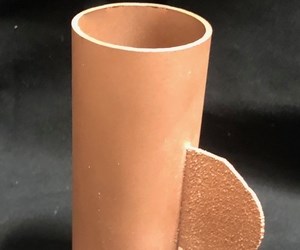Optomec Releases Pure Copper DED Process
Optomec has developed a pure copper Additive Manufacturing process using Optomec’s LENS directed energy deposition (DED) systems.
Optomec has developed a pure copper Additive Manufacturing process using Optomec’s LENS directed energy deposition (DED) systems.

“Copper … enables the addition of high thermally-conductive features like cooling fins, the addition of soft metal sealing surfaces and high electrically-conductive surfaces for power transmission,” says Cobbs.
“Pure copper is a big challenge for DED systems because of its high reflectance,” says Tom Cobbs, product manager for Optomec LENS systems. “The infrared wavelengths on most standard, laser-based AM systems are not readily absorbed by copper, making it difficult to establish a melt pool as the laser energy is reflected back into the source, causing all kinds of havoc. Our laser-based solution is virtually immune to any back reflection, so the laser can operate at full power on reflective surfaces without any difficulty. Optomec engineers have developed process parameters to account for thermal conductivity differences, as well as big changes in absorption and have demonstrated efficient DED builds with pure copper.“
According to the company, establishing a DED process for pure copper is particularly important for designers of heat exchangers in a variety of industrial applications in industries such as aerospace and chemical processing. The Optomec copper process is also applicable to alloys of copper such as bronze, brass and cupronickel.
“We see this as a major milestone for LENS and DED additive manufacturing — because working with copper is essential for many of our customers. Copper … enables the addition of high thermally-conductive features like cooling fins, the addition of soft metal sealing surfaces and high electrically-conductive surfaces for power transmission,” says Cobbs.
Related Content
-
Velo3D Qualifies Aluminum Alloy to Support Formula 1 Customers
Aluminum alloy supports Formula 1 customers by enabling the production of parts requiring high thermal conductivity and durability, and is available to print in both 50 and 100 micron layers.
-
Semiconductors, Tungsten, AM Affordability and More from Formnext 2024: AM Radio #56
The trade show included increased applications for the semiconductor market, machine launches and technology advances aimed at cost cutting, plenty of LFAM and more. Listen to our conversation on Formnext 2024.
-
AddUp’s FormUp 350 Evolution Prints Parts Up to 1 Meter Tall
The FormUp 350 Evolution machine is designed to produce large metal parts with a high level of complexity and precision, which is an ability in high demand in the aeronautics, space, defense and energy sectors.











